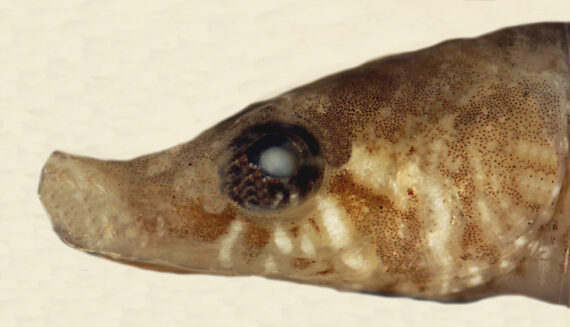Fringed Pipefish, Anarchopterus criniger
 Fringed Pipefish, Anarchopterus criniger. Fish collected from coastal waters off Key Largo, Florida, April 2016. Photograph and identification courtesy of Dr. Benjamin Victor, Coralreeffish.com.
Fringed Pipefish, Anarchopterus criniger. Fish collected from coastal waters off Key Largo, Florida, April 2016. Photograph and identification courtesy of Dr. Benjamin Victor, Coralreeffish.com.
The Fringed Pipefish, Anarchopterus criniger, is a member of the Pipefish and Seahorse or Syngnathidae Family, that is known in Mexico as pez pipa orlado. Globally, there are two species in the genus Anarchopterus, with this species being the only one found in Mexican waters of the Atlantic Ocean.
The Fringed Pipefish has three pale streaks radiating back and down from the lower half of the eye. They have 14 to 16 trunk rings with 3 short whitish bars or oval dots and 35 to 39 tail rings. The upper trunk, before the dorsal fin, has 3 prominent, regularly spaced black spots. The snout is short with a ridge along the center line and a ridge on the gill cover that angles up and back. They do not have anal and pelvic fins; the caudal fin has 10 rays; the dorsal fin has 15 to 21 rays, and the pectoral fin has 6 to 9 rays. The brood pouch in males is found under tail rings 13 to 20. They have poorly developed body ridges, the upper body and tail ridges are interrupted near the rear of the dorsal fin, the lower trunk ridge ends near the anus and the side trunk ridge joins the lower tail ridge under the dorsal fin.
The Fringed Pipefish is a demersal species that is found within seagrass, macroalgae and floating Sargassum at depths up to 11 m (35 feet). They reach a maximum of 10 cm (3.9 inches) in length. Reproduction is ovoviviparous and involves females depositing eggs in the male’s broom pouch where they are fertilized and remain from 10 days to 6 weeks until they hatch as miniature adults. The Fringed Pipefish is poorly studied with very limited information available about their lifestyle and behavioral patterns including specific details on age, growth, longevity, movement patterns, diet, habitat use, and reproduction.
The Fringed Pipefish has a limited distribution in Mexican waters of the Atlantic Ocean being limited to the northern coast of the Yucatán Peninsula in the Gulf of Mexico.
The Fringed Pipefish is a straightforward identification being the only pipefish found in Mexican waters of the Atlantic Ocean.
From a conservation perspective the Fringed Pipefish is currently considered to be of Least Concern with stable, widely distributed populations. Their long-term viability is threatened by the degradation of habitat from coastal development.